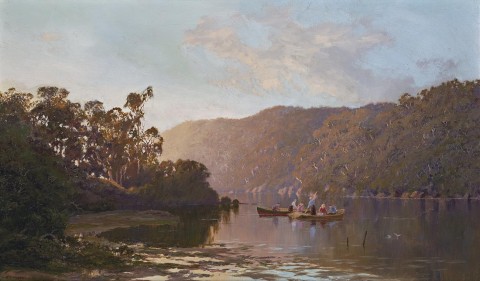AN AUTUMN SUNSET, LANE COVE RIVER, N.S. WALES, c.1910
WILLIAM CHARLES PIGUENIT
oil on canvas
46.0 x 76.5 cm
signed lower left: W. C. PIGUENIT
inscribed on gallery label on frame verso: An Autumn Sunset / Lane Cove River, NSW / W C Piguenit
bears inscription on label on stretcher verso: An Autumn Sunset / Lane Cove River / NS Wales
Private collection
Masterpiece Fine Art Gallery, Hobart
McRae Collection, Hobart
Christie’s, Hobart, 26 August 1996, lot 35 (as ‘An Autumn Sunset Lane Cove, New South Wales’)
Private collection, Sydney
26th Annual Exhibition, Art Society of Tasmania, Hobart, 1910 (label attached verso)
Johannes, C.E., and Brown, A.V., W.C. Piguenit 1836-1914: Retrospective, Tasmanian Museum and Art Gallery, Hobart, 1992, p. 68
William Charles Piguenit’s landscapes celebrate the sublime in nature, its wonder and grandeur, which so fascinated Eugene von Guérard and his contemporaries. Born in Hobart, he drew early inspiration from the atmospheric waters and mountains of Tasmania. Later, moving to Sydney, his earliest known painting of Lane Cove was shown in the 1883 exhibition of the Art Society of New South Wales. By 1886 he was living at Hunters Hill, overlooking the Lane Cove River, the subject of many future paintings. His interest in the panoramic river landscape, especially the effects of light on water, spread further. Within New South Wales he was drawn to the Parramatta, Nepean and Snowy rivers, to the Derwent and Lake Pedder in Tasmania, and abroad to the Conway River and Mount Snowdon in North Wales. The romantic in approach, curiosity led to awe, Mount Olympus, Lake St Clair, Tasmania, The Source of the Derwent, 1875, and The Flood in the Darling 1890, 1895, both in the collection of the Art Gallery of New South Wales, are classics of their kind. This grand Tasmanian work was the first oil painting acquired by the Art Gallery, its popularity reflected in it being the gift of fifty subscribers in 1875.1 In 1901 Piguenit was awarded the Wynne Prize for A Thunderstorm on the Darling. By now, he was held in such high regard that in 1902 the Gallery’s Trustees commissioned him to paint Mt Kosciusko, 1903 to commemorate the Australian Federation.
When An Autumn Sunset, Lane Cove River, N. S. Wales, c.1910 was exhibited in the 26th annual exhibition of the Art Society of Tasmania, Hobart, in May 1910, Piguenit was proudly acknowledged as ‘an artist of whom Tasmania is especially proud’.2 And our painting is described as ‘a remarkable one … in respect to reflections of light from behind a clump of trees and on the river’.3 The same painting was noted interstate, The Leader, Melbourne reporting that: ‘The gem of the half dozen is, I think, An Autumn Sunset. The golden glow seems to radiate real sunlight’.4
Remote in locale and overpowering in stature, his eminent panoramas were sometimes touched by a romantic melancholia. Even some closer to civilization seemed a little distant. Figures, boats, fishermen and warm sunlight were added as humanising touches. This is particularly so for Lane Cove subjects. People, though diminutive in size, walk along the riverbank in Lane Cove River from Cliffs Near Bridge, New South Wales, c.1890 – 1901.5 And the undated On Lane Cove River gives centre attention to the fishermen hauling the net into their boat.6 In An Autumn Sunset, Lane Cove River, N. S. Wales, two boats filled with young people relax and enjoy themselves on calm waters. Even birds join in. Autumn and sunset are in tantalizing harmony as ‘Seasons of mists and mellow fruitfulness’ abide in the dusk of departing day. Solitude has been dispelled à contre-jour, companionship and golden light.7
1. See Pearce, B., Australian Art in the Art Gallery of New South Wales, Art Gallery of New South Wales, Sydney, 2000, p. 35
2. The Mercury, op. cit., 3 May 1910, p. 7
3. ibid.
4. Helena, op. cit., p. 54
5. Leonard Joel, Fine Art Auction, Melbourne, 24 March 2015, lot 52
6. Ken & Rona Eastaugh Collection, Sotheby's, Melbourne, 4 May 2009, lot 49
7. John Keats, ‘To Autumn’, published in 1820
DAVID THOMAS
